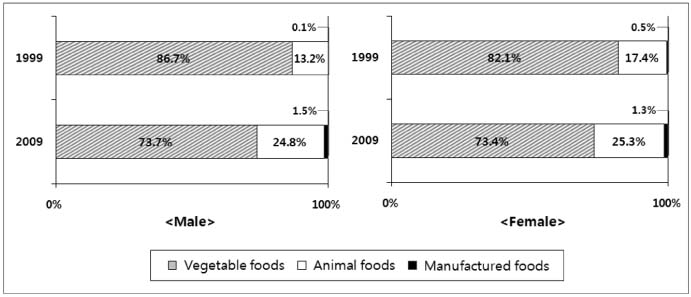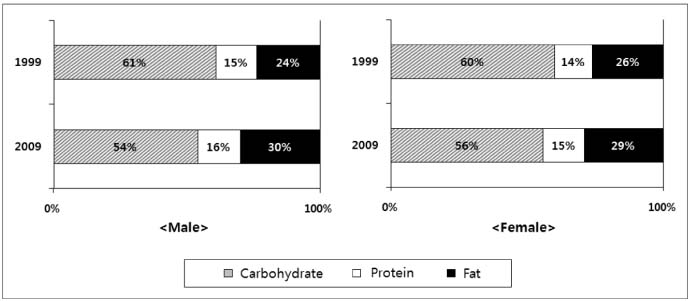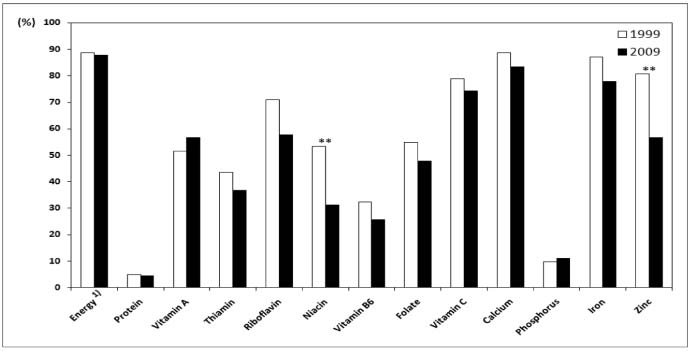Changes in Food and Nutrient Intakes of College Students between 1999 and 2009
- Affiliations
-
- 1Department of Food and Nutrition, Chungbuk National University, Cheongju, Korea. taisun@chungbuk.ac.kr
- KMID: 2265167
- DOI: http://doi.org/10.5720/kjcn.2011.16.3.324
Abstract
- The purpose of the study was to examine the changes of food and nutrient intakes of college students between 1999 and 2009. Dietary survey of 169 college students was conducted by a 24-hour recall method for three days in 2009. Food and nutrient intakes in 2009 were compared with the data from 106 students collected by the same methods in 1999. The intakes of cereals & grain products and vegetables in 2009 were lower than those of 1999, but the intakes of meats, eggs, milk & milk products, and manufactured food were higher. The intake of rice per person decreased greatly from 452.2 g in 1999 to 351.4 g in 2009 in males, and from 306.9 g to 237.2 g in females. While the intakes of protein, fat, thiamin, niacin, vitamin B6, phosphorus, potassium, zinc, and cholesterol were significantly higher, the intakes of dietary fiber were significantly lower in 2009 compared to 1999 both in males and females. The nutrients consumed less than the Recommended Intakes were vitamin A, riboflavin, vitamin C, and calcium in males and additionally folate, iron, and zinc in females in both 1999 and 2009. The ratio of carbohydrate, protein and fat as energy was 61 : 15 : 24 and 60 : 14 : 26 in 1999, and 54 : 16 : 30 and 56 : 15 : 29 in 2009 in males and females respectively, showing that carbohydrate intake decreased and fat intake increased greatly. Our data suggest that nutrition education is necessary for college students to help them consume more vegetables and fruits and less fat and cholesterol.
Keyword
MeSH Terms
Figure
Cited by 5 articles
-
Comparison of the lipids levels, C-reactive protein and adiponectin in adolescent male by fat intake
Sung-Hye Lee, Mi-Young Park, Soon-Kyung Kim, Young-Ki Min
Korean J Nutr. 2012;45(4):303-314. doi: 10.4163/kjn.2012.45.4.303.Intake and blood concentrations of folate and their association with health-related behaviors in Korean college students
Han-Byul Jang, Young-Hee Han, Chandrika J Piyathilake, Heon Kim, Taisun Hyun
Nutr Res Pract. 2013;7(3):216-223. doi: 10.4162/nrp.2013.7.3.216.Comparison of dietary habits, perception and consumption frequency of fast foods between youths working part-time at fast food restaurants and other food-related services
Mi Yang Jo, Taisun Hyun
J Nutr Health. 2014;47(3):206-213. doi: 10.4163/jnh.2014.47.3.206.Trends in energy intake among Korean adults, 1998-2015: Results from the Korea National Health and Nutrition Examination Survey
Sungha Yun, Hyun Ja Kim, Kyungwon Oh
Nutr Res Pract. 2017;11(2):147-154. doi: 10.4162/nrp.2017.11.2.147.Consumption of health functional food and dietary habits, nutrient intake and dietary quality of college students in Incheon
So Young Kim, Jeong Soon You, Kyung Ja Chang
Korean J Nutr. 2013;46(2):166-176. doi: 10.4163/kjn.2013.46.2.166.
Reference
-
1. Cheong SH, Chang KJ. Anthropometric measurement, dietary behavior and nutrient intake of the nation-wide college students attending a nutrition education via internet. J Korean Soc Food Sci Nutr. 2006. 35(5):565–571.2. Choi MJ, Jo HJ. Studies on nutrient intake and food habit of college students in Taegu. Korean J Nutr. 1999. 32(8):918–926.3. Choi SN, Chung NY, Song CH, Kim SR. Bone density and nutrient intake of university students. Korean J Food Cult. 2007. 22(6):841–847.4. Chung HJ, Chang KJ. A study on correlations between dietary nutrients and body composition of college students. J Korean Soc Food Sci Nutr. 2006. 35(10):1378–1384.5. Han YH, Yon MY, Hyun TS. Effect of prune supplementation on dietary fiber intake and constipation relief. Korean J Community Nutr. 2008. 13(3):426–438.6. Hyun TS, Han YH. Comparison of folate intake and food sources in college students using the 6th vs. 7th nutrient database. Korean J Nutr. 2001. 34(7):797–808.7. Kim HY, Jeon DW. Relationships among personality preferences, dietary habit and nutrient intake of university students. Korean J Food Cult. 2003. 18(5):418–427.8. Kim KH. A study of the dietary habits, the nutritional knowledge and the consumption patterns of convenience foods of university students in the Gwangju area. Korean J Community Nutr. 2003. 8(2):181–191.9. Kim WS, Kim MJ, Hyun TS. Differences in characteristics and dietary habits between volunteers and selected subjects in nutrition survey. Korean J Community Nutr. 2004. 9(4):511–518.10. Koh MS, Kim SE. A study of the dietary habits, diversity of food intake and nutrient intake of Silla university students. J Nat Sci. 2006. 15:31–44.11. Korea Health Industry Development Institute. Development of nutrient database - 5. Dietary Fiber Composition of Foods -. 2005.12. Korean Nutrition Society. Recommended Dietary Allowances For Koreans. 1995. 6th Revision.13. Korean Nutrition Society. Recommended Dietary Allowances For Koreans. 2000. 7th Revision.14. Korean Nutrition Society. Dietary Recommended Intakes for Koreans. 2005.15. Korean Nutrition Society. Food values. 2009.16. Korean Nutrition Society. Dietary Recommended Intakes for Koreans. 2010.17. Lee MS, Kwak CS. The comparison in daily intake of nutrients, quality of diets and dietary habits between male and female college students in Daejeon. Korean J Community Nutr. 2006. 11(1):39–51.18. Lee YS. A study on the eating behavior, nutrient intake and health condition of college students attempting weight control in the Daegu Area. J East Asian Soc Diet Life. 2003. 13(6):577–585.19. Ministry of Health & Welfare. Korean National Health and Nutrition Examination Survey. 1999.20. Ministry of Health & Welfare, Center for Disease Control and Prevention. Korea Helath Statistics 2008, Korea National Health and Nutrition Examination Survey. 2008.21. Sung MJ, Chang KJ. Correlations among life stress, sleep, anthropometric measurement and nutrient intakes of college students. J Korean Soc Food Sci Nutr. 2007. 36(7):840–848.22. Yon MY, Hyun TS. Dietary habits, food frequency and dietary attitudes by gender and nutrition knowledge level in upper-grade school children. Korean J Community Nutr. 2008. 13(3):307–322.23. You JS, Chin JH, Chang KJ. Prevalence of constipation, bowel habits and nutrient intakes of college students in Incheon area. Korean J Nutr. 2009. 42(8):702–713.24. You JS, Chin JH, Kim MJ, Chang KJ. College students' dietary behavior, health-related lifestyles and nutrient intake status by physical activity levels using International Physical Activity Questionnaire (IPAQ) in Incheon Area. Korean J Nutr. 2008. 41(8):818–831.25. Yu JY, Ro HK. Gender differences in obesity rates, nutrient intakes, and dietary behaviors among college students. J East Asian Soc Diet Life. 2009. 19(6):846–855.
- Full Text Links
- Actions
-
Cited
- CITED
-
- Close
- Share
- Similar articles
-
- Changes in Food and Nutrient Intakes of College Students between 1999 and 2009
- A Study on Beverage Consumption Pattern Associated with Food and Nutrient Intakes of College Students
- A Comparative Study on Food Habits and Nutrient Intakes among High School Students with Different Obesity Indexes Residing in Seoul and Kyunggi-do
- The Nutrient Intakes of Rural High-Schoolers with Depressire Tendencies
- A Survey of Food and Nutrient Intakes in Female College Students







